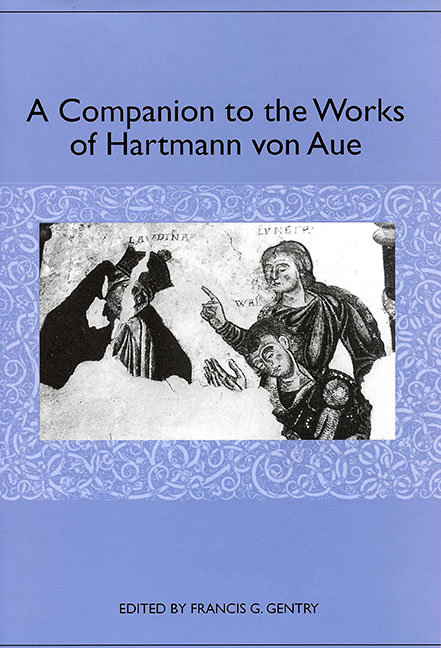Book contents
- Frontmatter
- Contents
- Acknowledgments
- Introduction
- Hartmann's Theological Milieu
- Hartmann von Aue as Lyricist
- Hartmann von Aue and Chrétien de Troyes: Respective Approaches to the Matter of Britain
- Gender and Love in the Epic Romances of Hartmann von Aue
- The Two-Fold Path: Erec and Enite on the Road to Wisdom
- The Body in Pain in the Works of Hartmann von Aue
- Illness and Cure in Hartmann von Aue's Arme Heinrich and Iwein
- Hartmann's Legends and the Bible
- Hartmann's Works in the Visual Arts
- The Medieval Literary Reception of Hartmann's Works
- A Tale of Sacrifice and Love: Literary Way Stations of the Arme Heinrich from the Brothers Grimm to Tankred Dorst
- Editions and Translations of Hartmann's Works
- Works Cited
- Notes on the Contributors
- Index
Illness and Cure in Hartmann von Aue's Arme Heinrich and Iwein
Published online by Cambridge University Press: 27 April 2017
- Frontmatter
- Contents
- Acknowledgments
- Introduction
- Hartmann's Theological Milieu
- Hartmann von Aue as Lyricist
- Hartmann von Aue and Chrétien de Troyes: Respective Approaches to the Matter of Britain
- Gender and Love in the Epic Romances of Hartmann von Aue
- The Two-Fold Path: Erec and Enite on the Road to Wisdom
- The Body in Pain in the Works of Hartmann von Aue
- Illness and Cure in Hartmann von Aue's Arme Heinrich and Iwein
- Hartmann's Legends and the Bible
- Hartmann's Works in the Visual Arts
- The Medieval Literary Reception of Hartmann's Works
- A Tale of Sacrifice and Love: Literary Way Stations of the Arme Heinrich from the Brothers Grimm to Tankred Dorst
- Editions and Translations of Hartmann's Works
- Works Cited
- Notes on the Contributors
- Index
Summary
In two of Hartmann von Aue’s courtly epics, the Arme Heinrich and Iwein, medicine plays an important role. The focus is not, however, as one might expect, on injuries received in tournament or battle, but on internal disorders that afflict the knightly protagonists and lead to their inner conversion: Heinrich suffers from leprosy, and Iwein descends into temporary madness. The two epics were written in close proximity to one another, and share more than the author's strong interest in illness. Susan Clark, for instance, points to numerous parallels in language and plot: both protagonists are described as examples of knightly virtue; they withdraw from society when they fall ill, establish symbiotic relationships with simple folk — Iwein with a hermit, Heinrich with a peasant family — and both undergo a mental transformation at the sight of female nudity (130–33, 153–54). On the level of language, the most striking parallel is perhaps the use of the word wunschleben for the chivalric life both protagonists initially strive for (138), and from which, ironically, they are “cured” by their respective illness. Leprosy and madness were also dealt with in the medical literature of the time, which constituted by far the biggest body of medieval technical writing or Fachliteratur. In what follows, the ideas surrounding leprosy and madness contained in medical literature will be compared with Hartmann's treatment of the subject, and the question how knowledgeable Hartmann really was in the theory and practice of medieval medicine will be explored.
Leprosy, a common disease in medieval Europe, stigmatized its sufferers in a similar fashion as AIDS did in the late twentieth century. Today we know that leprosy is an infectious disease caused by Mycobacterium leprae,which is related to tuberculosis bacteria (Richards, xv–xvi; Brody, 22–34). Symptomatic leprosy has an incubation period of several years, and manifests itself in a variety of ways ranging from nerve damage that can lead to paralysis of fingers and toes, to skin lesions that can scale and turn into discharging sores, throat infections resulting in hoarseness of the voice, eye damage that can ultimately cause blindness, as well as erosion of nasal cartilages and bone necrosis, and loss of hair. Modern medicine is capable of curing leprosy with drugs, provided that it is diagnosed early and treated promptly.
- Type
- Chapter
- Information
- A Companion to the Works of Hartmann von Aue , pp. 125 - 140Publisher: Boydell & BrewerPrint publication year: 2004



